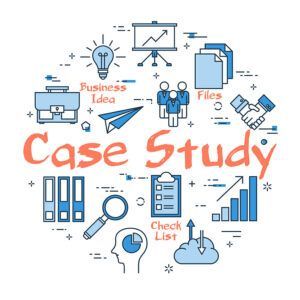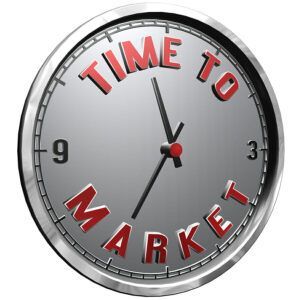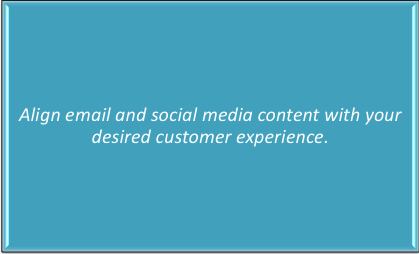Strategic Customer Experience – Two Case Studies
Customer experience defines your brand in an online world. In my last post , I suggested your messaging has both an external and an internal effect which can be valuable to many audiences.
Companies only survive and thrive when they meet the needs and solve the pain points of their customers.
The promise-makers in your organization, marketing and sales, and the promise-keepers in your organization, operations, must be in alignment. This is why the messaging you do, on your website and elsewhere, must radiate in all directions.
There was a time when customers knew your brand primarily from the marketing promises which were made. Today, there are too many ways potential customers can do diligence on the actual way you keep the promises you profess.
Yelp reviews, GlassDoor, Google, and a myriad of other sites allow people to review your performance. All of these matter because they represent your customer experience as reported by your customers.
What is customer experience? I see two ways to discuss the topic. There is operational customer experience and strategic customer experience.
Both aspects of customer experience are important. In your role as CEO, delegate the responsibility for operational customer experience improvement to a trusted subordinate so you can devote your time and resources to strategic customer experience improvement.
Strategic customer experience requires change and coordination across many functions in your business; a role for a CEO.
Operational Customer Experience
At one level, I’m sure you recognize customer experience negatives; waiting in line, being put on hold, being misdirected to the wrong person, mistakes in billing, rude customer service, missing web page links, wrong phone numbers, not being able to talk to a real person, … almost too many ways to mention how bad experiences can occur.
One way to create good customer experience is to work on ways to eliminate bad customer experience.
I don’t wish to take anything away from these efforts to eliminate issues as they are important to your business. On the other hand, I view these as operational issues which should be addressed, but not as strategic customer experience initiatives.
Strategic Customer Experience
In this post, I will relate two cases studies which I believe were successful on a strategic level. I was personally involved in these and remember almost all the details as hundreds of hours were devoted to making these successful.

Two Strategic Customer Experience Case Studies
Case Study #1: Competing with Short Lead-times
When I served as the President of the BPI Division for HNI Corporation, we had a business which marketed itself primarily to retail office furniture dealers. The company marketed and manufactured low-cost office furniture systems. Typically, retail dealers served small and medium size businesses in their local communities.
A retail dealer usually had a store with showroom and a few offices. Salespeople worked on the showroom floor and served customers as they came in the door. Some had warehou

ses in a second location.
In contrast, a “contract dealer” had an outside sales team. Rather than wait for customers to come to the retail location, the contract salesperson would identify projects and pursue the architect, designer, or facility manager who most influenced the purchasing decision.
The value of the customer versus the cost of a sale meant most small businesses weren’t served by a contract salesperson.
Small businesses don’t always plan everything much in advance and might sign a lease for a new space and/or expansion of their business which involved hiring more people. Faced with a deadline for a move and perhaps already having a relationship with a dealer, the small business person would usually go to the nearest retail dealerships, explain their issue and ask what they could do and how soon could it be done.
This was our critical moment. We wanted the retail dealer to suggest our product line. This was the focal point of our strategy.
The first part of our solution was to offer our product line three different ways where the dealer could respond quickly without a long lead-time for the products.
Fast
The first way to buy products from us was to order “normally” where our lead-times from order to shipment were three weeks. Shipping typically took another week so a dealer could promise “four weeks” and be able to perform. About 40% of our business was ordered in this fashion. This was also the way to get the best price from us.
Faster
The second way a dealer could order was to request a “five-day” lead-time from order to shipment. Including delivery, a dealer could be ready to do an installation in two weeks. We charged more for this, at first about 5%. This was also about 40% of our business.
This gave us some operational heartburn. Orders didn’t necessarily flow in a constant manner and there were times where we took Monday off but worked Saturday in the same week.
We decided to raise the price for the five day lead-time to a 7% premium over the normal program to see if we could get business to align more with the three week delivery.
It didn’t work as we intended. There was no detectable shift in the way dealers ordered and no complaints. The extra charges simply went to the bottom line (unlucky, huh). To fully understand, consider that most businesses, ours included, strive to make about 10% profit. With the tweaking of one marketing program we increased our profits by 20%.
Fastest
The third way we established was to have most of our key products available through a wholesale channel of distribution. There were approximately 50 wholesale locations which carried our products in the USA. A dealer could buy from these wholesalers who would typically deliver in 48 hours or less. The downside was the wholesaler charged about 25-30% more than what a dealer would pay if they purchased directly from us.
This was fair. That was the value added by the wholesaler. This channel of distribution worked very well for us. There were many situations where products were needed in that time frame.
Things Which We Had to Do Well
We spent hundreds of hours changing our manufacturing processes to be “just-in-time”. We did factory process development projects to the point where we could manufacture any product in any color in any order with no set-ups and no cost for one-at-a-time production.
We didn’t accomplish this with work-in-process inventory. Instead we eliminated set-ups. Our work-in-process was so low the accountants counted it only once per year.
We also implemented daily factory scheduling. The previous method was to schedule everything once per week.
We Added More to Our Value Proposition.
We created a unique guarantee; “On-Time or On-Us”. What we meant by this was we would pay the freight for the customer if we didn’t ship on time.
We created “BPI University”. Dealers could send their operations people to a hands-on class where they could learn best practices in installation.
We became the first company in our industry in the US to create a library of products for CAD Space Planning, saving a dealer’s time in the specification process.
Creating a strategic customer experience is a complete team effort, not just something done by sales, marketing, and customer service departments.
Results
Our brand became associated with short-lead times. This was our reputation. I remember situations where we knew we were going to miss a shipment date because of a product quality issue. We reacted by air-freighting the shipment so as to not violate our promises.
The organization was well aware of the cost for doing this and it didn’t take long for internal business practices to evolve to the place where we never again had to do air freight.
For the dealers, our product line became their single highest-margin offering. In visits with dealers I would assert that fact, challenge them to dispute what I said. Not once did I get an argument.
Last, but not least … the division ultimately grew revenues five-fold.
Case Study #2: Competing on “Time to Market”
 In this case, I served as Division President for APW Enclosures, a division of APW Worldwide. My division made technical enclosures for OEMs such as IBM, HP, Cymer Laser, Applied Materials, Data General, Sun Microsystems, Qualcomm, Silicon Graphics, and several others. The technical OEMs made their widget; we made the cabinet which housed it. These were typically the size of a refrigerator or larger, high-value, low-volume, with many configurations.
In this case, I served as Division President for APW Enclosures, a division of APW Worldwide. My division made technical enclosures for OEMs such as IBM, HP, Cymer Laser, Applied Materials, Data General, Sun Microsystems, Qualcomm, Silicon Graphics, and several others. The technical OEMs made their widget; we made the cabinet which housed it. These were typically the size of a refrigerator or larger, high-value, low-volume, with many configurations.
In addition to the “box”, we installed power supplies, fan trays, cabling and harness, backplanes, and other items which were not the OEM widget. We also had an internal supply chain which could provide injection molded components, electronic assemblies, and machined parts. There was very little need for Tier 2 partners.
We coined a self-serving terminology. We referred to ourselves as a Level 5 Supplier as a way to communicate our value proposition. Level 1 competitors made metal parts, Level 2 competitors made assemblies, Level 3 competitors made cabinetry but just the box, and Level 4 competitors did some component integration.
As a Level 5 Supplier, we could do it all. There was no need for another Tier 1 supplier to serve the OEM.
I was quite pleased one day when an OEM used that terminology in a discussion with us. I knew the origins.
The industry we were in was fragmented. Before the formation of our company, to distribute around the world, OEMs had to find, qualify, and manage multiple suppliers for the same item. The business plan for us was to acquire suppliers in all key areas where the OEMs manufactured and become the first and only single source supplier.
The pain point we identified had to do with “time to market”. In the world of technical products, the first to market usually makes great profits, the second might do ok, but if you were slower to market, you almost never got sufficient traction to be a meaningful competitor.
To address this pain point, we needed to demonstrate that doing business with us was the most assured way of being first to market.
Our solution was to offer three ways we could serve an OEM. Or said another way, they could make choices about the “customer experience” they wished to have.
Shared Resources
For OEMs who did a small amount of business with us, typically less than $5M per year, we placed their business in a “shared resource” work cell. In this approach to serving them, their orders were manufactured using the same equipment and processes as other OEMs.
In this type of manufacturing, the first orders received are the first manufactured. In other words, an OEM’s order was placed in a queue.
Dedicated Facilities
For OEMs who could give us business from $5M to $15M, we would create a work cell dedicated solely to them. Dedicated work cells allowed us to create a “just-in-time” work flow.
When an OEM would place an order, we could ship it immediately. The work cell would be triggered by the shipment to create replacement products. This is also known as a “pull system”.
This was a much better customer experience. OEMs unfailingly made many shipments at the end of the quarter.
In the shared resource approach, the customer’s order triggered the creation of parts and pieces for their final assembly. This might take weeks to accomplish. With dedicated facilities, the pull system was able to continuously replace the final assembly.
Dedicated Facilities and Staff
The third customer experience was reserved for customers who would commit to more than $15M in annual purchases.
For these customers, we not only provided dedicated equipment, we added a dedicated staff. Our people became experts in our customers’ products.
This was clearly the choice most customers wanted to make.
Things We Had to Do Well
We had to be experts at designing and manufacturing cabinetry. The brightest engineers at a technical OEM wanted to be involved in the design, specification, and development of the OEM’s widget(s). Designing cabinets was not the best way to progress in your career at the OEM.
I recall one case where an OEM approached us to get “our drawings”, as chaos in their own engineering departments resulted in the loss of all the specifications. Our information became the restore point for re-creating their intellectual property.
Another way we facilitated the relationship was to have one “seat” of every major supplier of CAD software. We had our native system but did all the translation behind the scenes.
We also had to be good at implementing “revisions”. Technical OEM’s seldom freeze their designs.
To maintain our Level 5 status, we also did “bolt-on” acquisitions to the business for technical or geographic considerations. We acquired a facility in Austin, TX for example. By serving Applied Materials locally we were finally able to earn preferred supplier status.
To serve outdoor telecom customers, we acquired “thick” backplane capabilities. As customers included more sophisticated power supplies and other peripheral electronics, we acquired a company capable to produce the electronics.
We also had to become experts at “costing”. I recall a case where we produced a cabinet which sold for about $1,200. Our customer wanted us to purchase and install a $15,000 power supply. How to price this?
We developed a costing algorithm which took into account the inventory turns on a third-party item. If the third party could give us weekly deliveries, we could see 52 turns and be reasonable with our charges. If the lead-times were longer, our turns would be less and we would increase the amount of the handling charge for the item. It was a win-win approach.
Results
Our biggest facilities were in Southern California. Because of their location, cost structure and business practices, they became the highest profit factories in the corporation.
We also won the biggest contracts in the industry.
In Retrospect
Both of these case studies were the result of a strategic plan led from the top. They were not an accident. They didn’t just happen by themselves. Senior management gave
direction
to the efforts.
In both cases, I know there was also strong alignment amongst the senior management team. There was almost no second-guessing about the “big picture”.
In today’s world there would likely be other enhancements to the customer experiences. Collaborative project management tools in the cloud would be part of the program. Orders, receipts, billings, quality reports, and other paperwork would be done with Electronic Data Interchange applications.
If done today, our email marketing and social media content would center on the customer experience which was intended. We would discuss the value of competing on the basis of lead-times, the simplicity of doing business with us, and the practices our customers should do to take the best advantage of our services.
Perhaps the biggest difference in the current business environment would be a shift to some form of a subscription business model. Increasingly, customers are looking for suppliers who adapt to this.
All the products and affiliated services would be packaged into a single monthly fee. If you need an office, Fast-growing WeWork is probably the leading example of the way businesses acquire and use office space in a subscription-based model.
Similarly, people who use technical equipment are buying the services from a subscription supplier like a network operating center.
If you can conceive a way to sell your product or service in a subscription model, you should be actively executing on a plan to move in that direction. If you don’t, it may not be long before a startup in your industry will build their brand around the strategy.
When Do You Know You Have a Completed Plan?
No plan lasts forever. Don’t adopt the mindset you that you can reach a point where you have the ultimate “customer experience”.
There is no such thing as a “completed plan” in the sense you are finished with the design of your process. The better way to think about it is to see it as something which is ever-changing to be better. There will be changes in technology which enable you to do different things and adjustments by your competitors.
Make it clear to your organization you are promoting continuous improvement, not the “flavor of the month”.

About the Author: Bob Kroon is a coach for high-performing Founders, CEO’s, and Owners. He founded Expeerious, LLC (expeerious.com) in 2015 to exclusively focus on coaching the success of Top Exec utives. For over 25 years, Bob served variously as CEO, COO, Division President, and Group Vice President.
The majority of his career was in manufacturing durable goods. Bob is an enthusiast and practitioner of Lean Thinking since 1986. He also has broad skills in M&A including financial modeling, deal structure, diligence, and post-close integration.
Bob’s current clients are diverse and include businesses in healthcare, agricultural products, robotics, luxury goods, and education.
To learn more about how Bob coaches and thinks, you can find over 200 questions he’s answered on Quora. Visit his website at: www.expeerious.com for additional blog posts.









